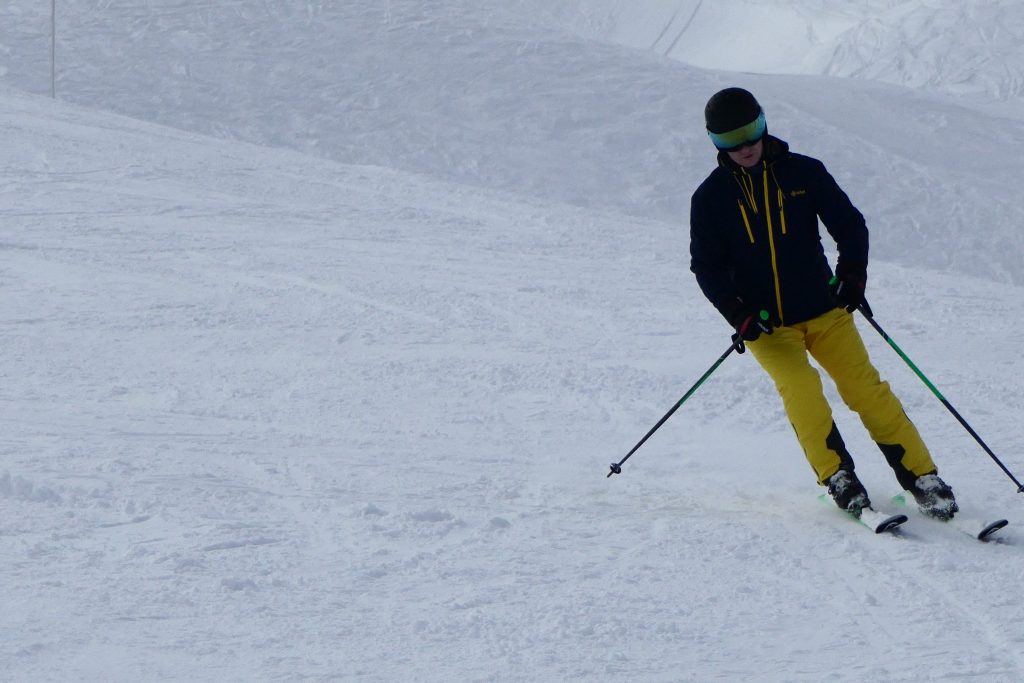We only had one session to try to make a difference so the first thing to do was watch Philip ski. After watching I didn’t need to ask many questions because the technical issues were very clear. One broken ACl, stemming and all the classic traps induced by standard ski instruction. The task would be to reconstruct the entire picture of skiing in 4 hours. Philip was up for it 100% and was a great student.
Initially I assessed that Philip wasn’t a skater but was informed that he was a strong skater. At first this appeared confusing until I realised then that while skating allowed me as a young adult to excel in skiing, I also had the great advantage of never having a ski lesson until after I could already ski! This allowed skating to guide me naturally.
There are 3 parts to the video clip
- Stemming – Static weight transfer to the outside ski – unstable
- Pivot – single pivot
- Dynamics – with early pressure
Dynamics (Dynamics link)
The Dynamics Link leads to a page dedicated to the basic dynamics exercises. Philip had no complications with this subject so everything we covered is referred to on that page.
The skier’s job (when moving forward) is to fall over – the ski’s job is to lift the skier back up.
- Starting a turn with dynamics
- Exiting a turn (getting out of your own way) with dynamics
Everything from the skis to the centre of mass has to pull inwards during a turn – the inward driving is only reduced when allowing the body to exit the turn.

Feet
- Stand on front of heels
- Roll both feet on the inside edge
- Activate adductor muscles – both legs
- When flexing stay on the heels – bend the knees and hips
- Keep shin pressure on the front of the boots – bouncing off the fronts – legs supporting weight
- Anterior tibialis (shin muscle) should contract to support the ankle.
- Ball of the foot only used when extending the ankle
- Forefoot rotates slight outwards (skating aspect)
- Limited lateral motion of knee when the ankle is strong – and no twisting or torque
The outside leg in the turn is the most active one – and from the foot upwards there is a “pulling inwards” for the entire duration of the turn.
We looked briefly at facing the pelvis downhill as opposed to the shoulders – this comes under “chi-skiing” on the fixed pages accessed at the top of the blog. There was not enough time to work on this subject but it prevents rotation and creates angulation and the ability to safely ski strongly with the fronts of the skis – and it protects the lower back.

Skating
Skating timing was introduced to fit in with the “inverted pendulum” action of dynamics. The skating brings stability during turn transitions and is a fundamental element of skiing. (Down/Up timing)

Pivot (Pivot Link)
Our adventures in pivoting are fully covered on the linked page…
Today’s main goal was to deal with the erroneous belief that control comes from getting onto the inside edge of the turning ski from the start of the turn. Understanding the pivot frees the skier from the tyranny of “inside edge”racing technique, particularly at turn initiations.
We included a brief look at the pivot on bumps.

Early Pressure (Double Skate)
Taking advantage of Philip’s skating experience we introduced the “double skate” where the turn was completed with the inside ski/leg being extended actively to take over the transition. This required awareness of the pivot elements of separating the inside edge of the foot from the inside edge of the ski – hence standing on the outside edge of the ski. The early pressure and “connection” with the ski and snow made Philip’s turns more progressive – preventing him from rushing the starts of the turn. (This also makes stemming impossible)
Altogether there was a lot to take onboard so Philip did really well – showing a clear grasp of everything we attempted. Skating and horse riding skills were able to be recruited to fit in with a natural athletic process and move away from the dangerous and severely limiting constraints of standard ski instruction.

